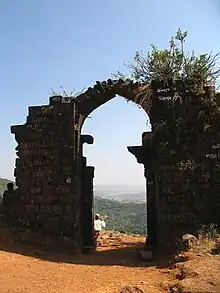Vishalgad
Vishalgad (also called Vishalgarh, Khelna or Khilna)[3] was a jagir during the Maratha Empire and then later part of the Deccan States Agency of the British Raj. It was governed by Deshastha Brahmins,[4] who were feudatories of Kolhapur State.[5]
| Vishalgad | |||||||
|---|---|---|---|---|---|---|---|
| Jagir of Maratha Empire and then British India | |||||||
| 1716[1]–1956[1] | |||||||
| Area | |||||||
• 1901 | 608.65 km2 (235.00 sq mi) | ||||||
| Population | |||||||
• 1901 | 30807 | ||||||
| History | |||||||
| History | |||||||
• Established | 1716[1] | ||||||
• Independence of India (abolition of the estate) | 1956[1] | ||||||
| |||||||
| Source: Solomon & Bond (1922)[2] | |||||||
| Vishalgad | |
|---|---|
| Kolhapur district, Maharashtra, India | |
 One of the few surviving structures on Vishalgad | |
 Vishalgad | |
| Coordinates | 16.906419°N 73.741683°E |
| Site information | |
| Owner | Government of India |
Fort
A fort had existed at Vishalgad long before it became a jagir. The Maratha emperor Chhatrapati Shivaji Maharaj had escaped to it after being besieged at Panhala Fort in 1660[6] and in 1844 it was one of the forts of Kolhapur State that initiated a rebellion against a regent called Daji Krishna Pandit who had been installed by the British to govern the state in 1843 at a time when the natural heir to the throne was underage. He took direction from a political agent of the East India Company and among their actions were reforms to the tax of land. These reforms caused much resentment and, despite Kolhapur having refrained from involvement in the previous Anglo-Maratha Wars, a revolt against the British began in 1844. The rebellion began with soldiers locking themselves into hill-forts such as those as Panhala and Vishalgad, and then spread to Kolhapur itself.[7]
References
- Vishalgad Jagir.
- Solomon, R. V.; Bond, J. W. (1922). Indian States: A Biographical, Historical, and Administrative Survey. Asian Educational Services. p. 110. ISBN 9788120619654.
- "Vishalgad". Maharashtra Tourism Development Corporation. Retrieved 2017-07-14.
- Johnson, Gordon (2005). Provincial Politics and Indian Nationalism: Bombay and the Indian National Congress 1880-1915. Cambridge University Press. p. 102. ISBN 9780521619653.
- Ramusack, Barbara N. (2004). The Indian Princes and their States. Cambridge University Press. p. 146. ISBN 978-1-13944-908-3.
- Gordon, Stewart (1993). The Marathas 1600-1818. Cambridge University Press. p. 68. ISBN 978-0-52126-883-7.
- Gott, Richard (2011). Britain's Empire: Resistance, Repression and Revolt. Verso Books. p. 343. ISBN 978-1-84467-738-2.